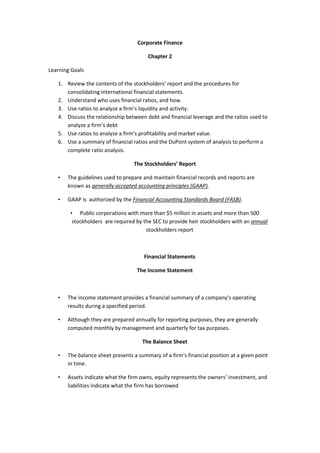
Corporate finance chapter 2
- 1. Corporate Finance Chapter 2 Learning Goals 1. Review the contents of the stockholders’ report and the procedures for consolidating international financial statements. 2. Understand who uses financial ratios, and how. 3. Use ratios to analyze a firm’s liquidity and activity. 4. Discuss the relationship between debt and financial leverage and the ratios used to analyze a firm’s debt 5. Use ratios to analyze a firm’s profitability and market value. 6. Use a summary of financial ratios and the DuPont system of analysis to perform a complete ratio analysis. The Stockholders’ Report • The guidelines used to prepare and maintain financial records and reports are known as generally accepted accounting principles (GAAP). • GAAP is authorized by the Financial Accounting Standards Board (FASB). • Public corporations with more than $5 million in assets and more than 500 stockholders are required by the SEC to provide heir stockholders with an annual stockholders report Financial Statements The Income Statement • The income statement provides a financial summary of a company’s operating results during a specified period. • Although they are prepared annually for reporting purposes, they are generally computed monthly by management and quarterly for tax purposes. The Balance Sheet • The balance sheet presents a summary of a firm’s financial position at a given point in time. • Assets indicate what the firm owns, equity represents the owners’ investment, and liabilities indicate what the firm has borrowed
- 2. Statement of Retained Earnings • The statement of retained earnings reconciles the net income earned and dividends paid during the year, with the change in retained earnings • Statement of Retained Earnings • The statement of retained earnings reconciles the net income earned and dividends paid during the year, with the change in retained earnings. Statement of Cash Flows • The statement of cash flows provides a summary of the cash flows over the period of concern, typically the year just ended. • This statement not only provides insight into a company’s investment, financing and operating activities, but also ties together the income statement and previous and current balance sheets.
- 3. Consolidating International Financial Statements • FASB 52 mandated that U.S. based companies translate their foreign-currency denominated assets and liabilities into dollars using the current rate (translation) method. • Under the translation method, companies translate all foreign-currency- denominated assets and liabilities into dollars at the exchange rate prevailing at the fiscal year ending date (the current rate). • Income statement items are usually treated similarly. • Equity accounts, on the other hand, are translated into dollars by using the exchange rate that prevailed when the parent’s equity investment was made (the historical rate). • Retained earnings are adjusted to reflect each year’s operating profits (or losses). Using Financial Ratios Interested Parties • Ratio analysis involves methods of calculating and interpreting financial ratios to assess a firm’s financial condition and performance. • It is of interest to shareholders, creditors, and the firm’s own management Types of Ratio Comparisons • Trend or time-series analysis :- Used to evaluate a firm’s performance over time • cross-sectional analysis :- Used to compare different firms at the same point in time o industry comparative analysis :- One specific type of cross sectional analysis. Used to compare one firm’s financial performance to the industry’s average performance • Combined Analysis :- Combined analysis simply uses a combination of both time series analysis and cross-sectional analysis Cautions for Doing Ratio Analysis • Ratios must be considered together; a single ratio by itself means relatively little. • Financial statements that are being compared should be dated at the same point in time. • Use audited financial statements when possible. • The financial data being compared should have been developed in the same way.
- 4. Ratio Analysis Example Ratio Types Formula Result Benchmark Current Ratio total current assets Times 1.5 total current liabilities It means for 1 $ liabilities we have 1.5 Liquidity assets to cover it Ratios Quick Ratio Total Current Assets - Inventory Times 1 total current liabilities It means for 1 $ liabilities we have 1quick assets to cover it Inventory Cost of Goods Sold ( COGS) Times The more the best Turnover Inventory Average Accounts Receivable Days The less the best Collection Net Sales/360 Period 360 ( number of days year) Activity ACP Ratios Average Accounts Payable Days The more the best Payment Annual Purchases/360 Period APP Total Asset Net Sales Times The more the best Turnover Total Assets Financial Debt Ratio Total Liabilities/Total Assets % The lower the best Leverage Ratios Times EBIT/Interest Interest Earned Gross Profit Gross Profit/Net Sales % Margin GPM Operating EBIT/Net Sales % Profit Margin OPM Net Profit Net Profits After Taxes/Net % Profitability Margin Sales Ratios NPM Return on Net Profits After Taxes/Total % Total Assets Assets (ROA) Return on Net Profits After % Equity (ROE) Taxes/Stockholders Equity Earnings Per Earnings Available to Common Stockholders Number of Shares Outstanding
- 5. Share (EPS) Price Market Price Per Share of Common Stock Earnings Per Share Earnings (P/E) Ratio
- 6. DuPont System of Analysis • The DuPont system is used to dissect the firm’s financial statements and to assess its financial condition. • It merges the income statement and balance sheet into two summary measures of profitability: ROA and ROE as shown in Figure 2.2 on the following slide. • The top portion focuses on the income statement, and the bottom focuses on the balance sheet. • The advantage of the DuPont system is that it allows you to break ROE into a profit on sales component, an efficiency-of-asset-use component, and a use-of- leverage component.